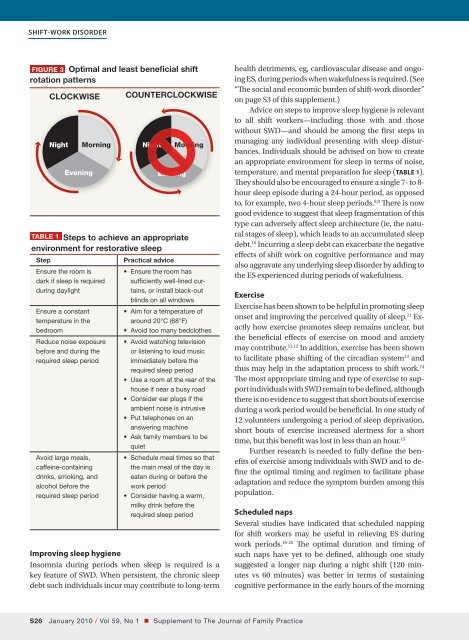SHIFT WORK DISORDER - myCME.com
SHIFT WORK DISORDER - myCME.com
SHIFT WORK DISORDER - myCME.com
- No tags were found...
Create successful ePaper yourself
Turn your PDF publications into a flip-book with our unique Google optimized e-Paper software.
Shift-work disorderFigure 3 Optimal and least beneficial shiftrotation patternsTable 1 Steps to achieve an appropriateenvironment for restorative sleepStepClockwiseNightEveningEnsure the room isdark if sleep is requiredduring daylightEnsure a constanttemperature in thebedroomMorningReduce noise exposurebefore and during therequired sleep periodAvoid large meals,caffeine-containingdrinks, smoking, andalcohol before therequired sleep periodCounterclockwiseNightEveningPractical adviceMorning• Ensure the room hassufficiently well-lined curtains,or install black-outblinds on all windows• Aim for a temperature ofaround 20°C (68°F)• Avoid too many bedclothes• Avoid watching televisionor listening to loud musicimmediately before therequired sleep period• Use a room at the rear of thehouse if near a busy road• Consider ear plugs if theambient noise is intrusive• Put telephones on ananswering machine• Ask family members to bequiet• Schedule meal times so thatthe main meal of the day iseaten during or before thework period• Consider having a warm,milky drink before therequired sleep periodImproving sleep hygieneInsomnia during periods when sleep is required is akey feature of SWD. When persistent, the chronic sleepdebt such individuals incur may contribute to long-termhealth detriments, eg, cardiovascular disease and ongoingES, during periods when wakefulness is required. (See“The social and economic burden of shift-work disorder”on page S3 of this supplement.)Advice on steps to improve sleep hygiene is relevantto all shift workers—including those with and thosewithout SWD—and should be among the first steps inmanaging any individual presenting with sleep disturbances.Individuals should be advised on how to createan appropriate environment for sleep in terms of noise,temperature, and mental preparation for sleep (TABLE 1).They should also be encouraged to ensure a single 7- to 8-hour sleep episode during a 24-hour period, as opposedto, for example, two 4-hour sleep periods. 8,9 There is nowgood evidence to suggest that sleep fragmentation of thistype can adversely affect sleep architecture (ie, the naturalstages of sleep), which leads to an accumulated sleepdebt. 10 Incurring a sleep debt can exacerbate the negativeeffects of shift work on cognitive performance and mayalso aggravate any underlying sleep disorder by adding tothe ES experienced during periods of wakefulness.ExerciseExercise has been shown to be helpful in promoting sleeponset and improving the perceived quality of sleep. 11 Exactlyhow exercise promotes sleep remains unclear, butthe beneficial effects of exercise on mood and anxietymay contribute. 11,12 In addition, exercise has been shownto facilitate phase shifting of the circadian system 13 andthus may help in the adaptation process to shift work. 14The most appropriate timing and type of exercise to supportindividuals with SWD remain to be defined, althoughthere is no evidence to suggest that short bouts of exerciseduring a work period would be beneficial. In one study of12 volunteers undergoing a period of sleep deprivation,short bouts of exercise increased alertness for a shorttime, but this benefit was lost in less than an hour. 15Further research is needed to fully define the benefitsof exercise among individuals with SWD and to definethe optimal timing and regimen to facilitate phaseadaptation and reduce the symptom burden among thispopulation.Scheduled napsSeveral studies have indicated that scheduled nappingfor shift workers may be useful in relieving ES duringwork periods. 16-22 The optimal duration and timing ofsuch naps have yet to be defined, although one studysuggested a longer nap during a night shift (120 minutesvs 60 minutes) was better in terms of sustainingcognitive performance in the early hours of the morningS26 January 2010 / Vol 59, No 1 • Supplement to The Journal of Family Practice
















